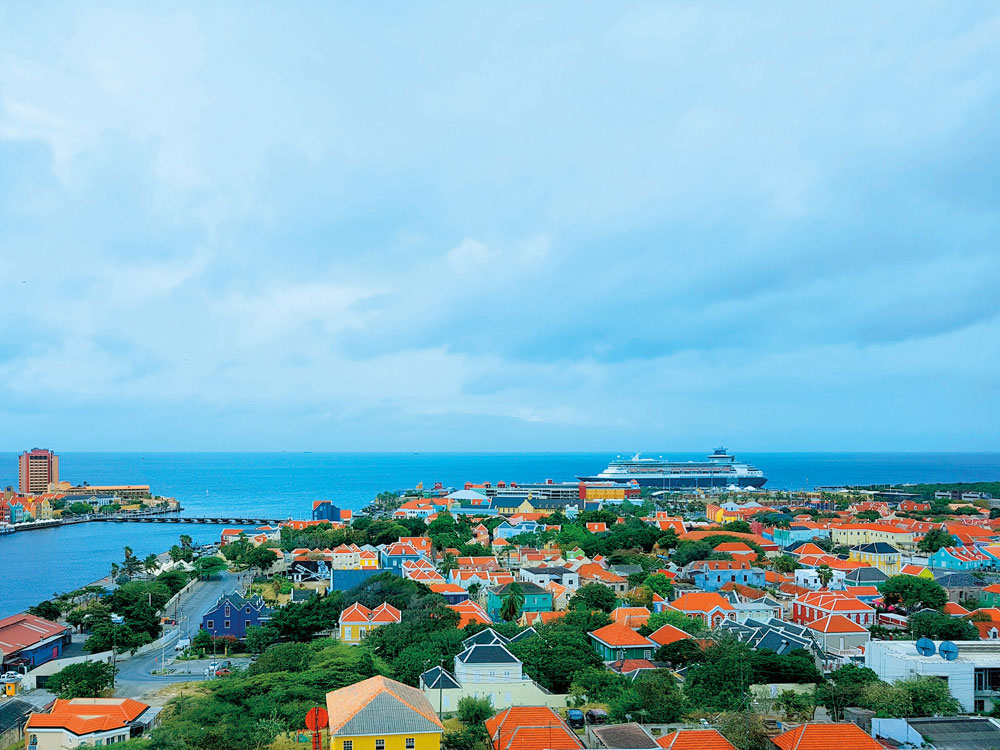History
Willemstad, founded in 1634 by Dutch colonists, began as a settlement on a small promontory, today known as Punda. By the eighteenth century, as the population swelled, Willemstad’s residents began building houses across St Anna Bay, and the district of Otrobanda — Papiamento for “the other side” — was born. Connected to Punda by the landmark floating Queen Emma Bridge since 1888, Otrobanda has become the buzzier half of Curaçao’s capital, known for its arts scene and restored historic buildings.
Living art
Curaçao’s street art movement took off in the 1980s, following the growing popularity of graffiti art in the United States and Europe. At the time, Otrobanda was not the most picturesque of areas, but its many abandoned walls and lonely alleyways offered a canvas for both young and seasoned artists to send messages of love for their city. Today, concerted restoration projects have made Otrobanda almost as neat and polished as Punda across the bay, but the neighbourhood’s informal art scene still thrives. Look out for stunning murals depicting nature, political satire, and even thought-provoking philosophical questions, as you explore the streets and blocks.
Breedestraat
Don’t be confused by Willemstad’s multiple Breedestraats. “Broad Street,” as the name translates in English, refers to a main shopping avenue. Otrobanda’s Breedestraat isn’t occupied by famous international names like Punda’s — here you’ll find local businesses, restaurants, and family-run hotels housed in picturesque nineteenth- and early-twentieth-century buildings, offering crafts and local fashion. Explore them for a more intimate look at Curaçao’s everyday life. Some of the smaller establishments are the size of closets, yet hold so much character — from the people who run them to the patrons who visit.
Green rum?
Curaçao takes its liquor very seriously: much time and effort are devoted to concocting some of the most unusual drinks in the Caribbean. Blue Curaçao — with its vivid turquoise hue and orange flavour — is a world-famous cocktail staple, but it has a local rival with an equally vivid colour and growing popularity. On Otrobanda’s Breedestraat is a hole-in-the-wall establishment with a special reputation. The Netto Bar (opened in 1954) is where you’ll find the notorious Rom Berde — green rum. Yes, green. Very sweet, sickly green, potion-like, and a hit with both locals and visitors. But what makes this drink so special and gives it this startling colour? The recipe is strictly confidential, bringing bold tipplers back for more.
Back in time
Shopping, art, proximity to beaches — Otrobanda has all of those, but can also offer a — sometimes sobering — history lesson, via two of Curaçao’s most important museums, the Kura Hulanda and Rif Fort. Both tell stories of maritime warfare and the enslavement of Africans on colonial plantations, which shaped present-day Curaçao.
On display at the Kura Hulanda Museum are chilling artifacts of the slavery era, such as chains, torture implements, and model ships. Other galleries explore the broader context of Caribbean, American, and African history, making them one of the best exhibits of the region’s colonial past, and a vital educational tool for islanders and visitors alike.
Nearby Rif Fort — which translates as “Reef Fort” — is located at the entrance of St Anna Bay and the Otrobanda quarter. In 1828, King William I of the Netherlands ordered the fort’s construction, as part of a restoration of the island’s defences. During the Second World War, outfitted with machine guns, it protected the island from enemy vessels. Later the fort turned into a police station, and in its present incarnation it houses a popular shopping mall within its historic stone walls.
Head out
When you’re ready to explore the rest of Curaçao, the island’s beaches are obvious day-trip goals, but for a deeper experience, plunge into the quiet mystery of the Grotten van Hato —the Hato Caves — north of Willemstad near the airport. These 300,000-year-old rock formations have been a popular site with visitors since they opened to the public in 1991. The millenia-long erosion of coral limestone by salt water created these impressive caverns, which were once used by indigenous Amerindians for shelter and later as a place of refuge by escapees from Curaçao’s colonial slave plantations. On the glittering cave walls are petroglyphs of animals long extinct, and among the stalactites and stalagmites your guide will point out fanciful “faces” and shapes of all kinds.
Coordinates
12.1° N, 68.9° W
Sea level
Caribbean Airlines operates two return flights weekly to Curaçao International Airport from Trinidad, with connections to other destinations in the Caribbean and North and South America























